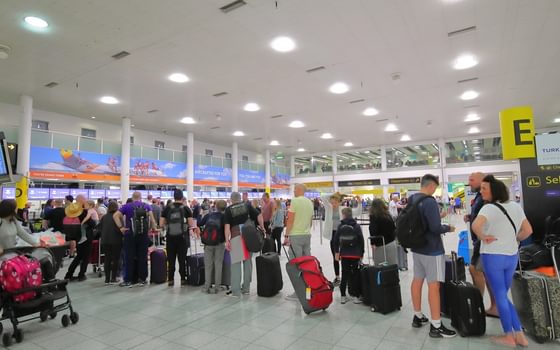Climate impact of airport expansions will be up to eight times worse than previously claimed
Expansion proposals from Bristol, Leeds Bradford, Southampton and Stansted airports have ignored up to £13.4bn worth of damage to the climate
21 May 2021
The climate impact of four planned regional airport expansions will be between two and eight times higher than their proponents claim, according to research from the New Economics Foundation (NEF) published today. The report finds that these four schemes are likely to account for an increase in annual airport-level emissions of up to 3.7m tonnes of CO2 and CO2-equivalent emissions in 2035, the year of the government’s new climate target. This is equivalent to putting around 1.8m additional cars on Britain’s roads.
The report finds that applications to expand Bristol, Leeds Bradford, Southampton and Stansted airports have ignored up to £13.4bn worth of combined potential damage to the climate. This damage comes through emission at high altitude of pollutants such as carbon dioxide, aerosols, nitrogen oxides, and water vapour. The majority of this cost will fall on the shoulders of wider society, either as social damage from climate breakdown or in the cost of other parts of the country having to accelerate their emissions reductions in order to meet the UK’s climate targets.
The report finds that the four airports have not provided credible estimates to decision makers of how their expansion schemes will affect the climate crisis and the cost of this impact. As a result these airports have overstated the economic case for expansion and understated how much harm they will cause. NEF analysis has found that around 65% of these emissions costs will not be recouped by current regulations on the aviation sector such as the UK’s new Emissions Trading System (see notes).
Four airports have applied to expand via the local planning process: Leeds Bradford and Southampton have had their applications approved, and Bristol and Stansted are at the inquiry stage following initial refusals from their local councils. In addition, Gatwick, Heathrow and Luton airports are also applying to expand via a government approval process.
The report recommends that, in the light of a lack of credible information in these airport expansion applications, the government should halt all active applications. It argues that any decisions on airport expansion should take into account the upcoming government aviation decarbonisation strategy, the government’s new target to cut emissions 78% by 2035, and the Committee on Climate Change’s recommendation for no net expansion in UK airports. In addition, the Department for Transport should make sure that any future airport expansion applications, including larger expansions at Gatwick, Luton and Heathrow, take into account the impact of non-CO2 emissions and the monetised cost of damage to the climate.
The report finds that the four airports’ estimates of their climate impact are not credible because:
- All four schemes assume that the aviation sector will be using currently undeveloped technologies to deliver rapid fuel-efficiency savings over the next few decades. Two of the schemes (Southampton and Leeds Bradford) don’t even consider the possibility that these fuels and technologies may not be widely available, even though this would significantly increase the climate impact of the expansions.
- Three of the four airports (Bristol, Leeds Bradford and Stansted) do not account for the impact of non-CO2 emissions like aerosols, water vapour and nitrogen oxides, which can double or even triple the climate impact of airport expansions.
- Three out of the four airports (Bristol, Leeds Bradford and Stansted) do not look at how more flights coming into the airport as a result of expansion will affect its climate impact.
- Three out of the four airports (Leeds Bradford, Southampton and Stansted) have not put a monetary value on the climate impacts of expansion. As a result, these airports haven’t tested the potential impact of higher carbon prices in the future, and in failing to do so have not adhered to the government’s own guidance.
Alex Chapman, researcher at the New Economics Foundation, said:
“The number of people flying in the UK has collapsed over the last year because of pandemic travel restrictions, and these numbers are not expected to recover until 2024 at the earliest. Despite this, seven UK airports are applying to get even bigger, and yet more airports are expected to submit new applications in the next few years. Last month the government set a new legal target to slash the UK’s emissions by 78% by 2035, for the first time including our international aviation emissions. Against this backdrop, we can’t allow airport expansion schemes to play down their impact on the climate crisis. Our report raises concerns about the quality of the information decision makers were provided with when considering expansion applications. The Secretary of State should step in and conduct an independent review of all of these proposals and their compatibility with the UK’s climate targets.”
Notes
The New Economics Foundation (NEF) is a charitable think tank. We are wholly independent of political parties and committed to being transparent about how we are funded.
The report, Turbulence Expected, will be available at https://neweconomics.org/2021/05/turbulence-expected from 00.01 Friday 21 May 2021.
The ‘climate impact’ of air travel includes carbon dioxide emissions, other gases, and water vapour, and is also influenced by the location of those emissions (ie, at high altitude).
NEF have conducted evaluation and re-modelling of air travel forecasts and greenhouse gas emissions set out in each airport’s planning application documentation. NEF compared each airport’s modelling method and claimed emissions against best practice guidance set out by the Department for Transport and in the latest academic research. Where airports have not followed best practice, and where they have not tested a ‘maximum climate impact’ scenario, NEF performed this modelling. NEF modelling looked at the period 2025 – 2050 and used each airport’s own estimate of the rate of passenger growth over that period. All airports except Southampton have only modelled the climate impact of CO2 emissions from departing flights. NEF’s ‘maximum climate impact’ scenario also includes CO2 emissions from arriving flights, as well as non-CO2 emissions impacts derived using the multiplier approach recommended by the UK government. In addition, NEF costed up the value of these emissions. Costing is performed using government carbon prices, and the latest guidance on potential future changes to carbon prices and the recommended approach to ‘discounting’ the value of future costs.
The UK government recommends converting the greenhouse gas emissions of proposed developments/projects/policies into their monetary value. This reflects the cost to wider society of ‘recapturing’ those emissions, or if they are not recaptured, the cost of the damage that will be caused by climate breakdown. In practice, some of these costs are recouped by government through policies, in the case of aviation the UK Emissions Trading Scheme (UKETS) performs this role. Airlines must obtain credits from the UKETS system in order to be permitted to emit. However, the UKETS does not cover emissions related to non-CO2 drivers of global warming, and in addition, a large proportion of the credits are given away for free, an effective subsidy to airlines. The purchase of emissions credits is seen as a cost of emissions which is ‘internalised’ within the aviation sector. Emissions not captured, or credits given away for free by the UKETS, will mean a cost is borne somewhere else in society. This raises equity issues regarding who pays the price for aviation’s emissions.
Information on collapsing passenger numbers as a result of the pandemic can be found at IATA (2020) Deep losses continue into 2021. International Air Transport Association. Retrieved from: https://www.iata.org/en/pressroom/pr/2020 – 11-24 – 01/
In 3/4 of the airport expansion proposals reviewed, decision makers were not presented with climate impact estimates representative of the true likely range of impacts. Full table, based on NEF remodelling of airport appraisal documentation, of the climate impacts of four expansion schemes shown as annual averages over the period 2025 – 2050 based on different sets of assumptions can be found here: https://neweconomics.org/uploads/images/Turbulence_Table_9.png
All four non-NSI airports have significantly overstated the economic case for their schemes by ignoring material monetised climate costs. Graph showing accumulation of carbon costs (net present value) over 2025 – 2050 associated with non-NSI airport expansion schemes under each given assumption can be found here: https://neweconomics.org/uploads/images/Turbulence_Figure_4_text.png Baseline emission costs assume the central traded carbon price and the Green Book standard discount rate. Based on NEF remodelling of airport appraisal documentation.
Campaigns Stop airport expansions
Topics Transport Climate change Environment






